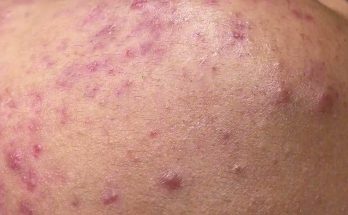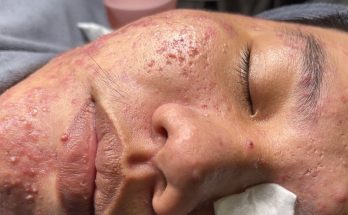:max_bytes(150000):strip_icc():format(webp)/Blackheads2-d09b699afb824802ad5d91e59ba1b9ab.jpg)
Blackheads are a type of acne that look like small, dark bumps. Also called open comedones, blackheads are caused by excess oil and dead skin clogging open pores.1 If you’re trying to remove blackheads, reach for treatments containing salicylic acid, alpha hydroxy acids (AHAs), and retinoids to reduce oil and dead skin cell buildup.
It may be tempting to squeeze out the gunk yourself, but avoid the urge to pick. Dermatologists can also offer professional-grade extractions and exfoliation treatments to remove stubborn blackheads.2
How To Remove Blackheads at Home
You can remove blackheads with over-the-counter (OTC) acne treatments containing ingredients that help exfoliate away dead skin and reduce oil production. However, don’t expect cleared pores overnight. It can take six to eight weeks to see results.3 Here are derm-approved treatments you can try at home.
Salicylic Acid Cleanser
Washing your face or body with a salicylic acid cleanser helps dissolve oil and dead skin cells clogging your pores. Salicylic acid is a beta-hydroxy acid (BHA) that acts as a chemical exfoliator to remove dead skin cells and reduce oil that leads to blackheads. Salicylic acid can also be drying, so use it once a day if it irritates your skin.42
Topical Retinoid
Topical retinoids are vitamin A derivatives that help increase cell turnover. This effect helps remove blackheads by clearing dead skin cells out of your pores and sloughing off dead skin cells so they don’t continue to clog pores. Most retinoids require a prescription, but Differin (adapalene) is available without a prescription.3
Layering skincare with salicylic acid and retinoids can be irritating since both products exfoliate the skin. If you use both to treat blackheads, try alternating applications in the morning and night if your skin is too sensitive for both. Retinoids also make your skin sun sensitive, so don’t skimp on daily sunscreen.5
Benzoyl Peroxide Cleanser and Retinoid
Dermatologists often recommend combining a retinoid and benzoyl peroxide cleanser to remove blackheads on the face or body. Benzoyl peroxide can help eliminate excess bacteria on your skin and reduce oil production to help remove blackheads.63
Sulfur and Resorcinol Treatment
Acne cleansers, lotions, and creams containing sulfur and resorcinol can help remove blackheads by reducing oil production and dissolving blackhead gunk. Resorcinol also helps remove dead skin cell buildup that causes blackheads.7
Alpha Hydroxy Acid (AHA) Treatment
Cleansers, serums, and creams containing alpha hydroxy acids (AHAs) can help remove blackheads by exfoliating the skin and unclogging pores. Popular AHAs include glycolic and lactic acid. Glycolic acid penetrates the skin even deeper than salicylic acid. In contrast, lactic acid is more gentle—which is ideal for dry or sensitive skin.8
Is It Okay To Squeeze Blackheads?
The short answer is no. Squeezing your blackheads is not a good idea. While tempting, squeezing blackheads can make acne worse, and dermatologists don’t recommend popping any blemish with your fingers or fingernails. Trying to squeeze blackheads can push the clogged oil and dead skin deeper into your pores, increasing inflammation and upping your risk of scarring.9
This extra inflammation can make your blackheads even more noticeable, and your pores appear enlarged. Touching blackheads can also introduce more dirt and bacteria into the pore—leading to infection and more painful acne. The safest way to squeeze blackheads is to visit a professional—like a dermatologist or esthetician—who can safely extract blackheads with sterile tools.9
Treatments To Avoid
Be wary about using pore strips, physical exfoliators, and pore suction tools to remove blackheads. If you’re dealing with blackheads on your nose, pore strips will only temporarily remove skin congestion. Pore strips won’t prevent future clogged pores and are actually ineffective at treating blackheads in the long run.
Exfoliating with abrasive brushes or scrubs won’t help you remove blackheads, either. This is because surface physical exfoliation can’t penetrate your pores deep enough to extract oil and dead skin cells that cause blackheads. Like squeezing your blackheads, comedone suction tools can also stretch and damage your skin.
Professional Treatments for Blackheads
If you’ve been trying OTC blackhead remedies for six to eight weeks without success, it’s time to see a dermatologist.3 You may need a prescription-strength retinoid to help remove your blackheads. Professional treatments like comedone extraction, microdermabrasion, chemical peels, hydrafacials, or laser therapy may also help remove persistent blackheads.
Comedone Extraction
During comedone extraction, a dermatologist or aesthetician often exfoliate the skin and then uses a sterile metal tool to squeeze out blackhead gunk. Blackhead extraction isn’t preferred because it takes more time and can be pricey. Still, your dermatologist may suggest extraction if other treatments don’t improve your blackheads.9
Microdermabrasion
Microdermabrasion is an exfoliation treatment that removes the top skin layer with an abrasive device. Professional microdermabrasion can penetrate blackheads deeper than at-home tools to exfoliate away clogged pores. Professional treatments also offer a more sterile environment to reduce your risk of infection. A microdermabrasion facial session typically takes about 30-40 minutes, and it may take between 5 and 16 treatments to remove blackheads. Microdermabrasion isn’t recommended for people using a retinoid, which can increase your risk of scarring. Insurance also doesn’t typically cover microdermabrasion.10
Chemical Peel
A chemical peel is another deep exfoliation treatment that can remove blackheads and improve skin texture.11 During a chemical peel, a dermatologist applies chemicals to remove skin layers and exfoliate away damaged and dead skin. As a result, chemical peels can help remove built-up oil and dead skin cells that form blackheads. Chemical peels vary in intensity and are available in refreshing/lunchtime, medium, or deep peels. Depending on the peel, you may experience mild irritation or intense skin redness and crusting. The skin can take a few days to multiple weeks to heal. Insurance may not cover chemical peels if your goal is to remove blackheads.12
Laser Therapy
Photopneumatic therapy is FDA-approved to treat blackheads and uses an intense pulsed light (IPL) laser and a vacuum to remove dead skin cells and oil from pores. After a session, you may experience mild burning and stinging, and it can take multiple sessions to see results. In-office and at-home visible light devices (like blue and red light) and infrared light treatments cannot treat blackheads.13
A Quick Review
If you’re trying to remove blackheads, avoid picking and squeezing blackheads to extract your pores. Pore strips will temporarily remove gunk, but they won’t offer lasting results. Instead, remove blackheads with skincare ingredients like retinoids, salicylic acid, and AHAs that exfoliate dead skin cells and reduce oil production.
See a dermatologist if you don’t notice any improvements in six to eight weeks. A dermatologist can safely extract blackheads or prescribe more potent retinoids. Dermatologists can also resurface the skin and remove blackheads with chemical peels or microdermabrasion treatments.



